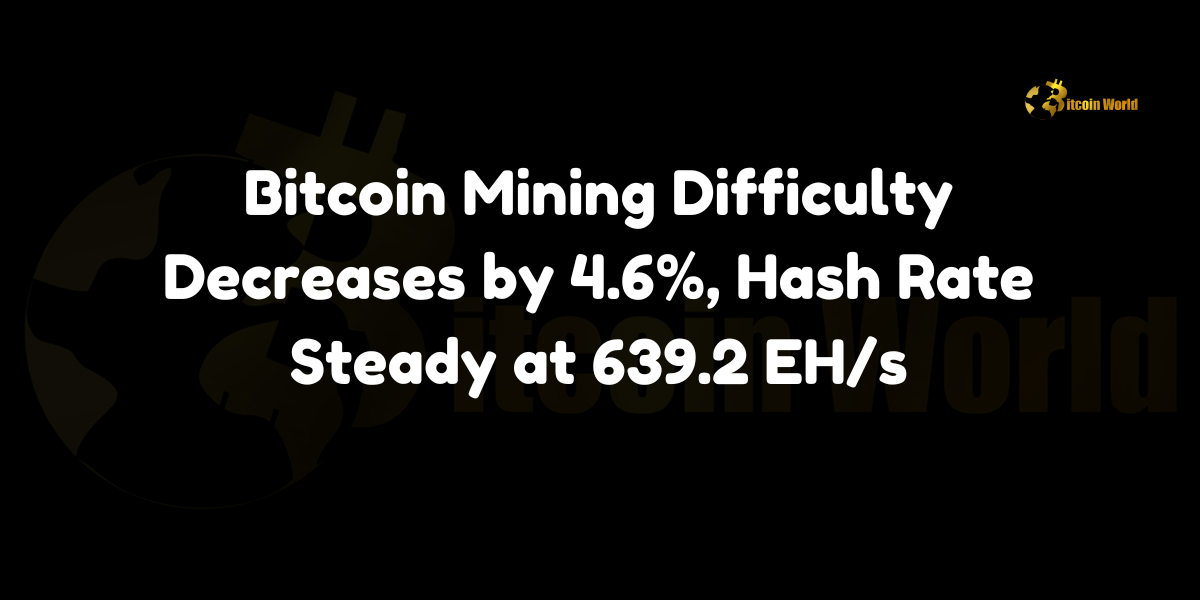Bitcoin Mining Difficulty Decreases by 4.6%, Hash Rate Steady at 639.2 EH/s
Bitcoin’s mining difficulty has dropped by 4.6%, bringing it to 88.4 trillion (T) as of 19:40 UTC on September 25, according to data from BTC.com. This marks a significant adjustment in the Bitcoin network as it continues to balance the complexity of mining based on the hash rate and miner activity.
With an average hash rate recorded at 639.2 exahashes per second (EH/s), the current state of the network reflects a shift in mining dynamics. The next difficulty adjustment, which is expected in approximately 14 days, is projected to bring a 0.6% increase, raising the difficulty to 88.94 T.

What is Bitcoin Mining Difficulty?
Mining difficulty in Bitcoin refers to the complexity of the mathematical puzzles that miners need to solve to add a new block to the blockchain. The network adjusts this difficulty approximately every two weeks (or 2,016 blocks) to ensure that blocks are mined roughly every 10 minutes, regardless of fluctuations in the hash rate.
When the hash rate increases, meaning more computing power is being used to mine Bitcoin, the network increases the difficulty to maintain the block interval. Conversely, when the hash rate decreases, the network lowers the difficulty, making it easier for miners to find new blocks.
Significance of the 4.6% Decrease in Mining Difficulty
The 4.6% decrease in mining difficulty reflects a response to changing conditions in the Bitcoin network. This adjustment is one of the largest reductions in recent months and suggests a slowdown in mining activity, potentially due to factors such as:
- Increased operational costs: As electricity prices and other costs associated with mining fluctuate, some miners may have temporarily shut down or reduced their mining operations.
- Post-halving adjustments: While it has been some time since Bitcoin’s last halving, the cumulative effect of lower rewards per block could still influence miners’ profitability and network activity.
- Hash rate variability: Fluctuations in the hash rate, driven by factors such as miner behavior and geographic distribution, also contribute to these periodic adjustments in difficulty.
Hash Rate Remains Strong at 639.2 EH/s
Despite the decrease in mining difficulty, Bitcoin’s hash rate remains robust at 639.2 EH/s. The hash rate is a critical measure of the computational power used by miners in the network. A higher hash rate is generally seen as an indicator of network security and miner confidence in the future of Bitcoin.
The strong hash rate suggests that while mining difficulty has decreased, many miners continue to operate efficiently, maintaining high levels of mining power. This stability in the hash rate underscores Bitcoin’s resilience as it continues to attract significant mining resources globally.
Projected 0.6% Increase in Mining Difficulty
The next difficulty adjustment, expected in about 14 days, is projected to result in a modest 0.6% increase to 88.94 T. This slight upward adjustment reflects the Bitcoin network’s dynamic nature as it seeks to maintain balance in block production rates while responding to changes in hash power.
As the network adjusts, miners will need to remain agile, managing their energy efficiency and operational costs to continue competing in an increasingly challenging environment.
Conclusion: Bitcoin Mining Difficulty Adjusts Amid Changing Network Conditions
Bitcoin’s latest mining difficulty decrease of 4.6% brings the difficulty to 88.4 T, reflecting a temporary easing in the complexity of mining operations. Despite this drop, the hash rate remains strong at 639.2 EH/s, indicating that Bitcoin mining continues to attract significant computational resources.
As the next difficulty adjustment approaches, with a projected 0.6% increase in two weeks, miners will need to adapt to these shifting dynamics to maintain their profitability and competitiveness in the evolving Bitcoin ecosystem.
Internal Link Reference
For more updates on Bitcoin’s mining activity and how difficulty adjustments impact the network, explore our article on the latest developments, where we cover key insights into Bitcoin mining and its role in the crypto market.
Disclaimer: The information provided is not trading advice, Bitcoinworld.co.in holds no liability for any investments made based on the information provided on this page. We strongly recommend independent research and/or consultation with a qualified professional before making any investment decisions.


